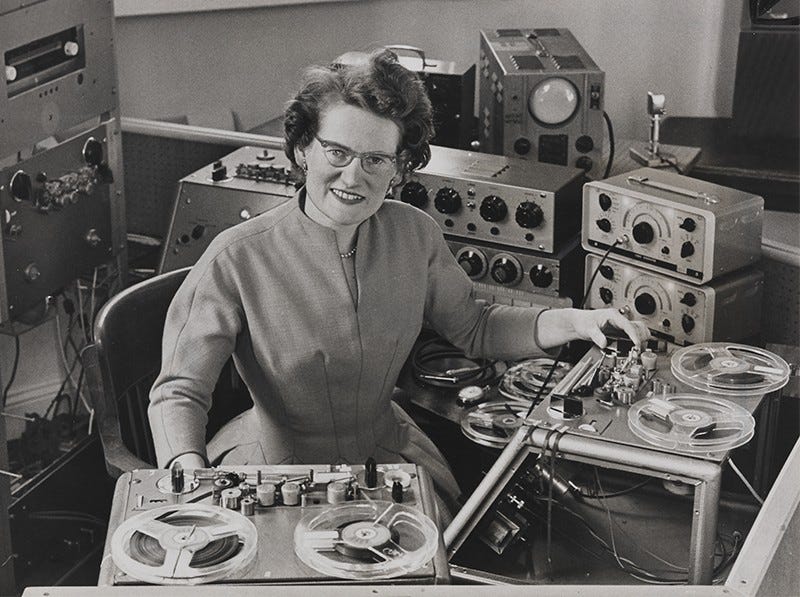HOLY NESTED SYNCHRONICITIES
Sam McPheeters, Tim Kinsella, Walter Murch, Dede Allen, Anne V. Coates, David Stubbs, Delia Derbyshire, Daphne Oram
Couple weeks ago I’m bingeing episodes of the podcast Apology while doing spreadsheet stuff at work (I can’t listen to podcasts when I’m working with words, only when I’m working with numbers). The host of the Apology podcast is Jesse Pearson, editor of Apology magazine, and a former editor of Vice Magazine who, unlike at least one of his former co-workers, has not started any increasingly violent (white) “men’s rights” groups of any kind. But he has started this podcast in which he talks with various luminaries about their favorite books, books they’ve been reading, books in general. I listened to several episodes in just a few days, and took note when his guest Sam McPheeters recommended the book The Conversations: Walter Murch and the Art of Editing Film by Michael Ondaatje.
I didn’t exactly know who Walter Murch was, but then again, I did; a pretty fascinating character, he was the editor for the film adaptation of Ondaatje’s novel The English Patient, and most notably a few masterpieces by Francis Ford Coppola that you and I know and love, such as the first two Godfather films, The Conversation, and Apocalypse Now. And then, on January 22nd, 2021, maybe a week after I listened to this Sam McPheeters episode and made this mental note of the Ondaatje/Murch book, someone on social media links to a new installment of “The Artist’s Bookshelf,” a regular Chicago Review of Books feature in which a guest lists a few books that they’re reading, or are otherwise important to them. This time the guest is Chicago mainstay Tim Kinsella from Cap’n’Jazz and Joan of Arc and everything else, who always has something interesting to say, and what should be the first book on his list but . . . The Conversations: Walter Murch and the Art of Editing Film by Michael Ondaatje. Kinsella says of the book that “its broad and practical applications make it the ultimate manual to interdisciplinary technique and reasoning.”
So, I’m like OK, I’ve gotta check out this Ondaatje/Murch book, as in literally check it out from the magnificent institution that is the Chicago Public Library (thank you CPL for your service, A++, would pay all the taxes again). I place a hold and one week later it’s at my trusty Rogers Park branch. I take it home and within an hour I’m on page 26, having already learned quite a few things, including the names of some great film editors who were women. Murch and Ondaatje talk about Thelma Schoonmaker, of course, who has edited almost all of Martin Scorsese’s films, but they also bring up Dede Allen, who edited classics like The Hustler, Bonnie & Clyde, and Dog Day Afternoon, and Anne Coates, whose long (60 years!) and varied editing career included credits like Lawrence of Arabia, The Elephant Man, Erin Brockovich, and many more; the last film she edited before her 2018 death was the 2015 adaptation of Fifty Shades of Grey, when she was almost 90 years old. Even though I’d seen a few films edited by both Allen and Coates, I never knew their names until reading about them in The Conversations.
About these women, Murch says, “If you made a list of the ten best editors ever, Anne Coates and Dede Allen would be in there. They’ve been an inspiration to a whole generation.” Ondaatje asks him, “Why do you think women like Dede Allen and Anne Coates end up as editors? It seems to be the profession where women have more power,” and Burch answers, “In fact, many of the editors of early films—back in the silent days—were women. It was a woman’s craft, seen as something like sewing. You knitted the pieces of film together. And editing has aspects of being a librarian, which used to be perceived as a woman’s job.”
Not even three days later I’m on the treadmill, reading one of my treadmill books, also from the Chicago Public Library (it’s best to read CPL books on the treadmill because of their sweat-resistant plastic jackets), this one Future Sounds: The Story of Electronic Music from Stockhausen to Skrillex by David Stubbs. Now, this is the second book I’ve read by David Stubbs, after his Future Days: Krautrock and the Building of Modern Germany, and I’m telling you, this guy is a really good music writer. I mean, at first you think he might give you a winning card in Bland Music Writer Bingo; he has an unmemorable name, one square down; he writes for The Wire, two squares down; free space, three squares down; he writes ‘histories,’ four squares down? Not so fast… just like his even less memorably named colleague (at The Wire!) Rob Young (author of the superb British folk music history Electric Eden and the fantastic Can book All Gates Open), Stubbs writes histories that are fun, readable, and informative. His descriptions of music itself, the way it sounds and behaves, are superb, and he also very insightfully weaves the sound of the music into the sociological fabric of its period.
So props to David Stubbs, but I’m really here to tell you about the nested synchronicity, the second synchronicity that came out of the first. You see, the McPheeters/Kinsella book recommendation synchronicity was heady enough, but then just three nights after reading Murch’s quote about film editing being considered “a woman’s craft” in said book, I read, right there on page 172 of Stubbs’s Future Sounds, within a chapter focusing on the 1960s electronic music made in Britian by Delia Derbyshire and Daphne Oram, the following: “One suspects that Derbyshire and Oram were permitted to operate as they did in the 1960s because electronics was somehow considered ‘woman’s work’, like hand-stitching or macramé, background work that did not apparently threaten male hierarchies.”
And I’m like, “Whoah. Holy nested synchronicity!”





